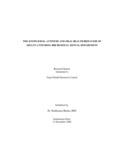Please use this identifier to cite or link to this item:
https://hdl.handle.net/20.500.14356/562| Title: | The knowledge, attitude and oral health behavior of adults attending Bir Hospital Dental Department |
| Authors: | Bhadra, Dr. Madhurima |
| Issue Date: | Dec-2003 |
| Keywords: | Oral Health Behavior |
| Abstract: | EXECUTIVE SUMMARY 1. The objective of the survey was to study the knowledge, attitude and oral health behavior of adult patients who come to Bir Hospital Dental Department for treatment in order to find out if there is any association of education to their knowledge, attitude and oral health behavior, so that recommendations can be made to oral health promoters, professionals, policy makers and stakeholders. 2. The study was carried out in adults who came to Bir Hospital Dental Department, Kathmandu, Nepal. The population studied was the adults who came for treatment. The sample identified was the first 10 males and females (five each) who came to the dental department. Purposive sampling was used along with the quantitative method of research. Data was collected for a period of 30 working days by two enumerators who filled out a questionnaire while interviewing the adults. 3. The limitations of this survey would be that Bir Hospital is not representative of the country or Kathmandu in terms of ethnic, economic and geographic distribution. 4. Data analysis was done using the SPSS package, where simple descriptive frequency statistics were used to describe the sample. To analyze the association of education to knowledge, attitude and behavior and the association of sex to consumption behavior cross-tabulation statistic was used. A Chi-square test was used to test the significance. 5. People mostly visit the hospital only if they have tooth ache. Most people are happy with the state of their teeth despite high incidence of toothache. People are unaware of what advice the dentist would give them no matter what their educational level is. 6. Cleaning of the teeth with a toothbrush is common but there is a lack in awareness about fluoridated toothpastes. The current consumption of sugar containing foods was not very high but, their childhood sugar consumption also needs to be taken into consideration. 7. Majority of the respondents have reported not to use harmful substances like tobacco, areca nut and alcohol. There was no significant association between education and frequency of consumption of these products but a significant association was seen between the sex of the respondent and their consumption habits with males having higher frequency of consumption. 8. There was a general consensus that it is not necessary to visit a dentist unless there is a major problem. No significant association was seen between the respondents’ educational levels and their knowledge, attitude and oral health behavior. 9. For a more holistic research, the survey should be augmented by a clinical examination of the oral cavity and observation of the patients’ habits. 10. Rigorous effort has to be made in the direction of oral health education for the general public and special target groups as well. Active campaigning and a strong advocacy are called for against the effects of tobacco containing products and their promotion and unrestricted marketing. |
| URI: | http://103.69.126.140:8080/handle/20.500.14356/562 |
| Appears in Collections: | Post Graduate Grant (PG) Reports |
Items in DSpace are protected by copyright, with all rights reserved, unless otherwise indicated.

